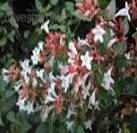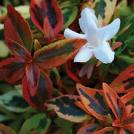| Kingdom | Plantae |
| Division | Magnoliophyta |
| Class | Magnoliopsida |
| Order | Dipsacales |
| Family | Caprifoliaceae |
| Genus | Abelia |
| Species | grandiflora |
| Binomial name | Abelia x grandiflora |
Other Common Names:
The other common name for the shrub Abelia is glossy abelia.
History
Abelias is named after a British physician Dr. Clark Abel.Abelia Edward Goucher, a hybrid abelia, was created in 1911 at the Glenn Dale Plant Introduction Center by Edward Goucher from a complex cross involving several species. It was the best abelia of its time and still retains that first place today. The genus have about 30 species having different traits like flower size, colour, growing pattern etc. Abelia x grandiflora is an interspecific hybrid between A.chinensis and A.uniflora.


Description
This shrub is attractive throughout the year; its growth habit varies from three to six feet. Flowering occurs from early summer to late winters. Belonging to the woodbine (Caprifoliaceae) family, this genus contains around 30 species of evergreen and deciduous shrubs that are found in eastern Asia and Mexico. These beautiful ornamental shrubs provide a blaze of vibrant floral colour throughout summer, and the deciduous species provide autumnal colour. Most species do not exceed 6 ft (1.8 m) in height, so they can be used to great effect when planted as a low informal hedge, and look equally impressive when planted singly. Typically grows on gracefully arching branches to two to three feet tall.



Range
Abelia which belongs to the Caprifoliaceae family is widely distributed in eastern Asia and Mexico.
Habitat
The Abelia Flowering Evergreen Shrub Plant thrives best in moist or wet conditions in partial shade. Easily grown in average, medium wet, well-drained soil in full sun to part shade. Best flowering in full sun. Prefers moist, organically rich soils which drain well. They are usually planted against a shelter such as a fence or a wall.
Cultivation
Plant in full sun or half shade in moist, acid soil. The shrub should be protected from cold winter winds, especially at the northern limits of its territory. It can be pruned in spring, since it blooms on new wood, although it looks best if pruned selectively rather than sheared. Thus it is easily grown in average, medium wet, well-drained soil in full sun to part shade. Best flowering in full sun. Prefers moist, organically rich soils which drain well. It is good to plant it two to three feet apart in order to form a natural or pruned hedge. Prunning and proper light (full sun or part shade) is essential for better growth. Prunning should be done immediately after flowering by thinning out the old wood. Pruning should be undertaken to keep the plant looking tidy whilst maintaining its natural arching habit. Trim to shape in late winter or spring, removing the cane ends and also some of the basal shoots in order to allow room for new growth. Propagate from half-hardened or softwood cuttings. It prefers moist, porous, slightly alkaline or loamy soil. Deadhead regularly to prolong flowering. In autumn after flowering lightly trim back the flowered shoots to retain a neat and tidy shape. Remove any dead or damaged wood in April.
Flowering Season
The lavender or pale pink, funnel-shaped flowers with orangish yellow throats are produced from July to September.
Pests and Diseases
Generally abelia is pest and diseases free. Powdery Mildew is usually found on plants that do not have enough air circulation or adequate light. The powdery white or grey fungus is usually found on the upper surface of leaves or fruit. Leaves will often turn yellow or brown, curl up, and drop off. Leaf spots are caused by fungi or bacteria. Brown or black spots and patches may be either ragged or circular, with a water soaked or yellow-edged appearance. Anthracnose is the result of a plant infection, caused by a fungus, and may cause severe defoliation, especially in trees, but rarely results in death. Sunken patches on stems, fruit, leaves, or twigs, appear greyish brown, may appear watery, and have pinkish-tan spore masses that appear slime-like.
Applications


• Its lacy appearance and long blooming season make it a good choice for a spot of honour in the yard. The abelia makes a good foundation and accent plant and combines well with broad-leaf evergreens.
• It is sometimes used as a hedge in the South.
• The plant attracts hummingbirds with its tubular blossoms.
• Thus it is used as a hedge plant, specimen, screen and cascader.
• It is also used in landscapes. Though it is edible have no culinary uses.

For centuries, humankind has been enchanted by the exotic nature of butterflies.Abelia is known to be one of the greatest attractor for butterfly so when you add butterfly attracting plants to your garden, not only do you get to enjoy these winged wonders, but you provide habitats for their survival, as well. Folklores tells that many girl children where named after the plant abelia.